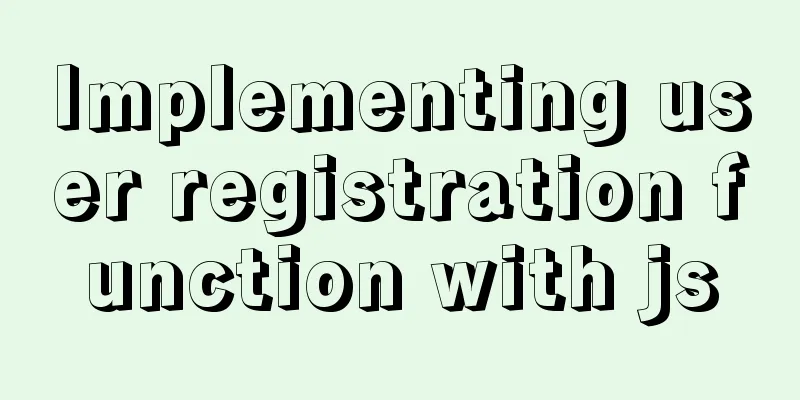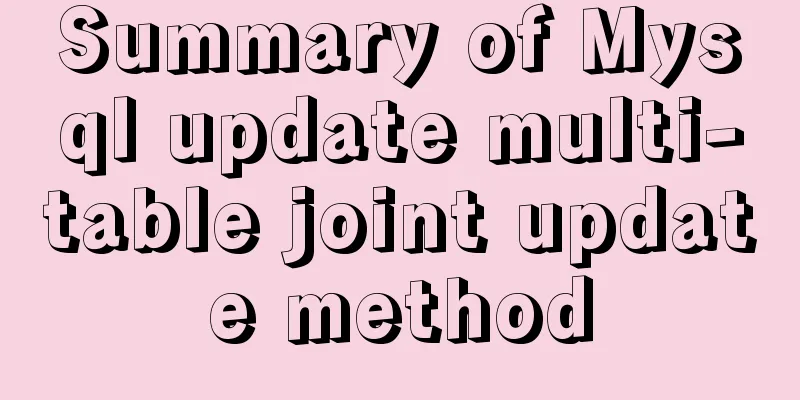JavaScript object built-in objects, value types and reference types explained

ObjectObjects in JS are a combination of attributes and behaviors , where attributes are static characteristics of objects and behaviors, also known as methods, are dynamic characteristics of objects. Objects in JavaScript are mainly divided into three categories:
Objects defined in the ES standard can be used in any ES implementation, such as Math String Number Boolean Function Object
Objects provided by the JS runtime environment, currently mainly objects provided by the browser, such as BOM DOM
Objects created by developers themselves Object DefinitionDefine a non-empty object
// Non-null object:
var object name = {
Property name: value,
...
Method name: function([parameters]){
Method body statements;
}
...
}
var p1 = {
color: 'black', //Add attributes to the object weight: '188g', //Attributes are separated by commas screenSize: 6.5,
call: function(name){//Add method to the object console.log("Outgoing call: "+name);
},
sendMassage: function(msg){
console.log("The message sent is: "+msg);
},
playVideo: function(){
console.log("play video");
},
playMusic: function(){
console.log("playing music");
}
}
console.log("Mobile phone color:"+p1['color']); //You can also use object['property'] to output property values console.log("Mobile phone weight:"+p1.weight);
console.log("Screen size:"+p1.screenSize);
p1.call("张三");//Call the object's sending method p1["sendMassage"]("helo");
p1.playVideo();
p1.playMusic();
console.log(p1);Creating an object using new Object() var p = new Object(); // Create an empty object p
p2.name = 'Liu Bei';
p2.sex = 'male';
p2.age = 32;
p2.sayHello = function(){
console.log('Hello');
}
p2.sayHello(); //Call object method You can use the constructor to create objects:
function Student(name,sex,age){
this.name = name; //This refers to the newly created object of the constructor this.sex = sex;
this.age = age;
this.show = function(){
console.log("Name: "+this.name)
console.log("Sex: "+this.sex)
console.log("Age: "+this.age)
}
}
var s1 = new Student('乔峰','男',28);//s1 is a new object created by the constructor, i.e., an instance s1.show();
var s2 = new Student('段煜','男',23);
s2.show();Note : The constructor may or may not have parameters. If there are no parameters, the parentheses can be omitted. Iterate over the members of an objectIterating over the properties and methods of an object: Using the for...in loop
for(var variable name in object name){
Loop Statement}
function Student(name,sex,age){
this.name = name;
this.sex = sex;
this.age = age;
this.show = function(){
console.log("Name: "+this.name)
console.log("Sex: "+this.sex)
console.log("Age: "+this.age)
}
}
// s2 is the object to be traversed var s2 = new Student('段煜','男',23);
for(var k in s2){
console.log(k);//output name sex age show()
console.log(s2[k]); // Output Duan Yunan 23 in sequence
}in operator <br /> Determines whether a member (attribute) exists in an object. If it exists, it returns true; if it does not exist, it returns false. JS built-in objectsJavaScript provides many commonly used built-in objects, including the mathematical object Math, the date object Date, the array object Array, and the string object String. Math ObjectsMath object: used to perform mathematical operations on numbers. There is no need to instantiate the object, and its static properties and static methods can be used directly. Math object: no need to instantiate Math.PI: arithmetic constant PI Math.abs(x): Returns the absolute value of xMath.max(args...): Returns the maximum numberMath.min(args...): Returns the minimum numberMath.pow(x,y): Returns x raised to the power of yMath.sqrt(x): Returns the square root of xMath.random(): Returns a random number between 0.0 and 1.0Math.round(x): Returns the integer closest to xMath.floor(x): Returns an integer less than or equal to x and closest to itMath.ceil(x): Returns an integer greater than or equal to x and closest to it Date Object Date object: You need to use new Date() to instantiate the object before you can use it . Creating an object Date() is a constructor that you can pass parameters to to generate a date object.
// 1. Create a Date object without parameters var date1 = new Date();
console.log(date1);
// 2. Create a Date object with the specified date and time by passing in the year, month, day, hour, minute, and second. // Month is 0-11
var date2 = new Date(2021,4,22,10,17,55);
console.log(date2);
// 3. Pass in a date and time string to create a Date object var date3 = new Date("2021-5-22 18:19:25");
console.log(date3);
console.log(date3.getMonth()) //4
console.log(date3.getTime()) // represents the number of milliseconds between the Date object and midnight on January 1, 1970 console.log(date1.toLocaleDateString()) // 2021/6/14
console.log(date1.toLocaleString()) //2021/6/14 11:17:36 PM
console.log(date1.getFullYear())//2021Array Object Array: It is a collection of data of the same type. It is similar to ordinary objects in function and is also used to store some values. Arrays use numbers as indexes to operate internal elements.
There are two ways to determine whether an object is an array:
Other array methods have been introduced in detail in previous articles, so I will not explain them here. String ObjectString object: string object, must be created using new String() Common string methods
- charAt(n) returns the string at position n - concat(s1,s2,...) concatenates multiple strings - charCodeAt(n) returns the ASCII code at position n - split('separator') converts a string into a string array according to the given separator - substr(start,length) extracts length characters from start to form a new string - substring(from,to) extracts the string between from and to to form a new string - toLowerCase() converts uppercase characters in a string to lowercase without affecting the original string and returns a new string - toUpperCase() converts all lowercase characters in a string to uppercase without affecting the original string and returns a new string - replace(str1,str2) replaces str1 in a string with str2 and returns the replacement result without affecting the original stringString object exercises
// Input a string of letters and count the number of times each letter appears in the string var str = 'abBSdXbdea';
var lower = new Array(26);//Store the number of times each of the 26 lowercase letters appears var upper = new Array(26);//Store the number of times each of the 26 uppercase letters appears // Initialize two arrays for(var i=0;i<lower.length;i++){
lower[i] = 0
upper[i] = 0
}
for(var k=0;k<str.length;k++){
if(str.charAt(k)>='a' && str.charAt(k)<='z'){
lower[str.charCodeAt(k)-97]++
}else if(str.charAt(k)>='A' && str.charAt(k)<='Z'){
upper[str.charCodeAt(k)-65]++
}
}
console.log(lower);
console.log(upper);
/* Input a decimal integer and a number system (2, 8, 16) and convert the decimal integer into the corresponding numerical format and output the remainder method:
m=15 k=8
m%k stores the remainder in an array*/
var m = parseInt(prompt('Please enter an integer:'));
var k = parseInt(prompt('Please enter a number system (2~16)'));
var result = ['0','1','2','3','4','5','6','7','8','9','A','B','C','D','E','F'];
var arr = new Array(); //Store the result of number system conversion var i = 0;
while(m!=0){//Convert m to a number system and put the remainder in the arr array arr[i] = m%k;
m = parseInt(m/k);
i++;
}
var str = '';
if(k==8){
str = '0';
}else if(k==16){
str = '0x';
}
for(var i=arr.length-1;i>=0;i--){
str += result[arr[i]];
}
console.log('The result of the conversion is: '+str);
Value Types and Reference Types Value type: simple data types (string, numeric, Boolean, undefined, null) Note: The characteristic of the reference type is that the variable only stores the address of a reference. When assigning a value to a variable, the object is not copied, but the two variables point to the reference of the same object. The following is an analysis of the stack and heap in memory
It can be seen that for objects stored in the heap memory, the variable actually stores a pointer, which points to another location. This pointer is used to find the properties and values of the objects stored in the heap, and each space is of different size, so specific allocation should be made according to the situation. This concludes this article about JavaScript objects, built-in objects, value types, and reference types. For more information about JavaScript basic objects, please search for previous articles on 123WORDPRESS.COM or continue browsing the following related articles. I hope you will support 123WORDPRESS.COM in the future! You may also be interested in:
|
<<: A brief introduction to the usage of decimal type in MySQL
>>: How to install MySQL 5.7.28 binary mode under CentOS 7.4
Recommend
Two ways to open and close the mysql service
Method 1: Use cmd command First, open our DOS win...
Description of the execution mechanisms of static pages and dynamic pages
1. A static page means that there are only HTML ta...
Detailed explanation of Angular parent-child component communication
Table of contents Overview 1. Overview of input a...
Solve the problem of MySQL using not in to include null values
Notice! ! ! select * from user where uid not in (...
A brief discussion on the manifestation and value selection method of innodb_autoinc_lock_mode
Prerequisite: Percona 5.6 version, transaction is...
Detailed explanation of how to enable https service in Apache under Linux environment
This article describes how to enable https servic...
How to allow all hosts to access mysql
1. Change the Host field value of a record in the...
How to change the domestic image source for Docker
Configure the accelerator for the Docker daemon S...
How to switch directories efficiently in Linux
When it comes to switching directories under Linu...
The difference between char, varchar and text field types in MySQL
In MySQL, fields of char, varchar, and text types...
Summary of several common ways to abbreviate javascript code
Table of contents Preface Arrow Functions Master ...
mysql security management details
Table of contents 1. Introduce according to the o...
JavaScript to achieve simple image switching
This article shares the specific code for JavaScr...
How to configure mysql5.6 to support IPV6 connection in Linux environment
Introduction: This article mainly introduces how ...
React concurrent function experience (front-end concurrent mode)
React is an open-source JavaScript library used b...













